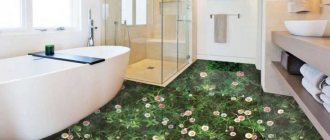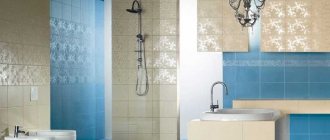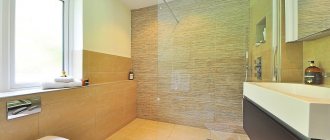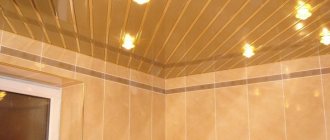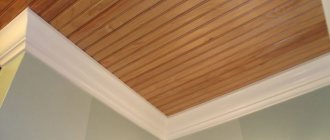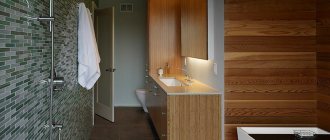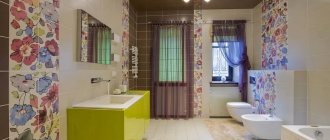The role of light in the bathroom interior
The installation of a lighting system in this room requires a responsible approach. There are certain difficulties in this process. First of all, when creating lighting, it is necessary to take into account specific operating conditions. Even in a spacious room equipped with high-quality ventilation, humidity and air temperature will periodically rise. Lamps located in the bathroom must be designed for these parameters.
When developing a lighting system diagram, choosing the location of lighting devices and their power, it is necessary to focus on the functions of light in the bathroom. Lighting:
- creates comfortable conditions for all procedures;
- emphasizes the advantages of plumbing equipment and finishing materials;
- is one of the main interior decorations;
- if necessary, performs visual correction of the room.
Lighting is one of the main decorations of the bathroom
In a large room, zoning is performed, allowing for each procedure to be allocated an autonomous area. In this case, individual lighting is provided for each zone. In small rooms, the main lighting fixtures are usually placed on the ceiling, at the top of the walls. But there must be additional lamps in the area where the mirror is placed. Otherwise, it will be difficult to shave and perform cosmetic procedures.
Proper placement of lamps will provide an opportunity to demonstrate the attractiveness of wall tiles, mosaics, and floor coverings. With the help of light in the bathroom, interior design can be made as expressive and sophisticated as possible.
The right light in the bathroom will make the interior more expressive
It is difficult to use decor in the design of this room. Its area is limited, difficult conditions do not allow decorating the interior with objects that do not have proper resistance to external influences. Lamps will do this function perfectly. They can become worthy decorations of the environment.
The need for bathroom renovations arises often. In most cases, you need to visually expand the room, raise the ceilings, and create a feeling of spaciousness. Light will provide significant assistance in solving this problem. Reflection of flows by glossy surfaces, high-quality lighting of light finishes will visually enlarge the room and add lightness to the interior.
The right light helps visually raise ceilings
Design techniques
Beauty is a subjective concept, but there are principles of harmony and consistency of details that are understandable to everyone on an intuitive level. For example, a huge chandelier will look bad in a small room. Don’t get too carried away with mixing styles and mixing classics and hi-tech. However, with good creative intuition, you can indulge in exquisite kitsch.
Focus on convenience
When decorating the interior, convenience should come first. A group of spotlights can be placed where they are needed. The devices must be positioned so that there are no shadows, observing the principles of uniformity and symmetry. Some designers advise focusing on some bright detail. The central lamp can also serve as such an element, but it is better to highlight an important element of the interior by directing rays at it or lighting it.
Take advantage of the layout
With a ceiling height of 3 m or more, you can use rays reflected from the walls and floor. To do this, lamps are mounted at the top of the wall, pointing down and slightly inward. If it is necessary to achieve softness and diffuseness, the devices are directed upward and hidden behind a wide baseboard or decorative casings to hide them from view.
Designate a work area near the sink
Particular attention should be paid to the work area near the sink. There shouldn't be any shadows here. If the rays are too bright, they will dazzle the eyes and create glare; if the intensity is insufficient, it will be difficult to carry out cosmetic procedures. It is better to make the lighting above the bathroom mirror as close to natural as possible so that it does not change the color of objects. It is most convenient to use sconces on flexible adjustable stands.
Podiums and steps can be decorated with LED strip - this will make them easier to notice. Using this technique, you can highlight any important element of the interior, not only from below, but also from above.
Specifics of electrical wiring in the bathroom
Deciding how to arrange the lamps in the bathroom and what lighting devices will be used in the system is necessary at the preparatory stage before the renovation. Wiring in this room is carried out in a hidden way; the following is required:
- create an accurate cable routing diagram;
- choose wires taking into account the power of all electrical appliances;
- make a secure, reliable connection.
When installing electricity in the bathroom, aluminum and copper cables with a cross section of 4 mm and 2.5 mm are used, respectively. To determine the exact size for a specific room, the total power indicator is divided by 220. However, you should not make your own choice of consumables for the lighting system. It is better to entrust this work to a specialist who will do the wiring.
Example lighting system plan
Having an accurate layout of light sources allows you to drill walls and ceilings in the right places, lay cables along optimal routes, and ensure convenient use of lamps.
Main requirements for lamps
There are many types of fixtures used in modern bathrooms. Models are selected taking into account specific room factors. There are general requirements for devices that will create light in the bathroom. They have to:
- have the required level of protection from moisture;
- correspond to the purpose and style of the interior;
- be easy to care for.
Each manufacturer of lighting products has models that have different levels of protection from dust, moisture, and mechanical influences. They all matter to this room.
All lamps must have the proper level of protection from moisture
Each lamp will be an important element of the interior, often performing not only practical, but also decorative functions. You need to choose models that will flawlessly cope with both purposes.
Regular cleaning is a must to maintain proper order. The design of lighting devices should ensure easy removal of dust and contaminants. All surfaces must be resistant to household chemicals, which will have to be used for cleaning.
The light in the bathroom also performs decorative functions
In conclusion
Bathroom lighting is a detail that performs several functions at once, and therefore the approach to organizing lighting requires taking into account a variety of factors: the type and power of the lighting fixture, location, safety, design, etc. With all this, it is important not to forget about safety precautions both at the stage of repair work and in the future. Remember that thanks to lighting you can create not only a comfortable, but also a cozy space.
The article was written for the site.
Tags:Bathroom, Lighting systems
Optimal levels of protection for a bathroom light fixture
Knowing how to decipher the labeling of lighting devices will help you choose the right light for your bathroom. Three numbers are used to indicate protection levels:
- the first stands for dust insulation;
- the second indicates tightness, preventing the penetration of moisture;
- the third shows the level of resistance to mechanical stress.
Based on dust protection, lamps are divided into 7 categories. The number “0” indicates the absence of protection, complete openness, the maximum dust resistance is indicated by “6”.
Protection level table
Based on water resistance, devices are divided into 9 categories. This is the most important indicator for the bathroom. Devices with the number “0” are not protected from moisture and are absolutely unsuitable for this room. Level 8 lamps can function while in water. It is not necessary to use them to decorate the interior of the bathroom. The water resistance category is selected taking into account the location of the device and the intensity of exposure to moisture.
The level of shock resistance varies in the range of 0-10. Maximum ratings for luminaires are optional. But devices placed in areas of possible accidental impacts must have decent strength. This will ensure safety in use.
What is a security index?
Lighting products are marked with IP indexes with a three-digit digital code. This code will tell a literate consumer a lot about the product he wants to buy.
So here's what these numbers tell us:
- First. This is the degree of protection against dirt and dust, increasing from 0 to 6.
- Second. This is waterproof from 0 to 8. With protection 8, the product can be immersed in water for a long time.
- Third. This is an impact resistance from 0 to 10. The mechanical impact on the product is measured in joules. Index 10 corresponds to 20J. With guaranteed shock resistance, the device may receive external damage, but its functionality and electrical safety will not be affected.
Knowing the labeling will help you purchase a product that the consumer is interested in using.
A mechanical shock inflicted on a vandal-proof device with a high degree of protection may result in a scratch or dent, but it will not lose its safe functionality.
Lamp placement and water resistance
When choosing light for the bathroom, you need to remember safety requirements. It is not necessary to buy all the lamps with maximum moisture protection for it. This indicator depends on the area in which the device will be located. There are recommendations from experts that you can follow when purchasing light sources.
- Zone I includes shower boxes, areas near the bathtub, and sinks. Lamps with IP from 674 can be selected for it.
- Level II zones include the upper part, located above the bathtub. There is a risk of contact with drops and shower jets. Light sources must be marked with IP from 452.
- Zones III are located half a meter from the bathtub and sink. In these areas, drops of water may fall on the lighting fixture. Models must have an IP of 242.
- Areas located far from sinks and bathtubs belong to zone IV. Condensation may accumulate in it, and the air will periodically have an increased level of humidity. You can place luminaires with IP from 011 in these areas.
Decoding the degree of protection (IP)
High-quality insulation of the working components of a lighting device eliminates the risk of a short circuit, which can lead to failure of the lamps or fire.
Lamps in bathroom fixtures
Not only lamp models, but also lamp types deserve careful selection. They must create comfortable light in the bathroom, provide a cozy atmosphere, be reliable, and cost-effective. Nowadays, household lighting devices are equipped with lamps:
- incandescent;
- halogen;
- luminescent;
- LED.
An incandescent lamp is cheap, when turned on, it immediately provides full lighting power and creates streams of warm shade. But such light sources do not last long and consume a lot of electricity. They cannot be installed in plastic shades, as the lamp gets very hot.
Incandescent lamps get very hot
Halogen models are much more economical than their filament counterparts. They last several times longer and are energy efficient. Often such lamps are installed in spots, point models. To create a lighting system, you can use 220 V or 12 V sources. Twelve-volt devices will require a special transformer.
Halogen lamps are energy efficient
Fluorescent lamps are mostly mounted near mirrors and sinks and provide high-quality illumination of the work area. The assortment includes models with different shades of glow. Experts do not recommend using fluorescent tubes in the bathroom. Their functioning depends on voltage and temperature fluctuations. In addition, the lamps make noise when operating, which can interfere with quality relaxation.
Fluorescent lamps for lighting mirrors
In bathroom lighting design, LEDs are now one of the most popular players. They have many advantages. LED light sources have a maximum service life and are characterized by low energy consumption. In addition, you can install colored LEDs, create the desired atmosphere, adjust the light intensity and its shades. There are many options in LED products, allowing you to choose models for main, additional lighting, and local lighting.
Colored LED light in the bathroom
General principles for placing lighting fixtures
Regardless of the size of the bathroom, three zones are created in it. This allows you to create comfortable conditions for all procedures. You need to determine how to position the light in the bathroom to ensure high-quality lighting of the areas:
- washing, cosmetic procedures;
- bathing, showering;
- washing, changing clothes, storing things.
Example of zone lighting in a bathroom
In the wash area, you need to provide high-quality lighting for the mirror and sink. The location of the lamps in the bathing area depends on the type of plumbing equipment. Light sources can be located in the box, above the bathtub, or in the shower corner. The changing and washing area can be illuminated by a common ceiling lamp. Additionally, spotlights can be installed in furniture for maximum convenience.
Location Tips
If there is a lack of light flux in the room, a multi-tier lighting system with three levels is considered an ideal option.
Basics
Depending on the location, there are ceiling, wall and floor lighting fixtures with manual or automatic activation.
On a regular painted ceiling, pendant lights with increased protection against moisture are often installed. For a ceiling surface decorated with plasterboard construction, plastic panels or slats, built-in lamps are preferred. They are very convenient, aesthetically pleasing and safe, as they have hidden wiring. In the case of a stretched fabric, spot lighting is suitable, and for a multi-level ceiling, LED lamps will be appropriate.
A classic solution for small rooms is the placement of a central chandelier.
If ceiling lighting is not enough, wall light sources are used. The placement location is chosen depending on the height of the walls. Lamps should not dazzle the eyes, so they are usually installed at a level of two meters from the floor plane.
When purchasing sconces for the bathroom, pay attention to the lampshades; they should be shaped like a sphere or flask and be closed.
The photo shows the interior of a bathroom in the attic with spotlights built into the suspended ceiling.
Floor lighting is most often in the form of backlighting, such as LED strip lights or sealed fixtures. To create a peaceful atmosphere in the room, it is possible to use closed lanterns, translucent lamps or portholes. Built-in floor lamps will add an unusual ambience to the bathroom and add mystery to the atmosphere.
Dividing the room into zones
Installing light in the bathroom depends on many factors: the area of the room, the arrangement of furniture and plumbing, ceiling height, placement of mirrors, surface finishes, etc. All details need to be taken into account.
The bathroom will have 4 zones:
- Area above the bathtub and in the shower. The space is characterized by high humidity, accumulation of steam and condensation. Powerful lamps cannot be installed here. Lamps whose power does not exceed 10-12 W are suitable.
- An area located in close proximity to a sink, shower stall and other plumbing equipment. Since splashes of water and drops are possible here, it is not recommended to install powerful lighting. A safe option would be 20-24 W lamps.
- A space located at a distance of half a meter from plumbing fixtures no longer has restrictions on the power of installed lamps.
- The area further away is always dry. Any lighting fixtures are allowed to be installed here.
Such zoning does not depend on the presence of a hood in the room and is used in all rooms, regardless of their size.
Lamp placement levels
The photo of the light in the bathrooms shows three levels of placement of appliances. Lighting is installed in this room:
- top,
- average,
- lower.
Ceiling lights are necessary for the convenience of using the room. They create the main light and illuminate all areas. In the range of lighting products you can find options for a room of any size, taking into account the style and design features. Chandeliers and lampshades can be located on the upper level; spotlights can be used in the bathroom.
Ceiling lights create the main light
Mid-level lighting is called task lighting. This area contains light sources that provide comfort during procedures. For the most part, wall-mounted models are chosen for these purposes.
Mid-level lamps provide comfort during procedures
Lower light is not a necessary element to create proper comfort. This lighting is decorative, used to give the interior originality and create a special atmosphere. In addition, installing lamps in the lower zone allows you to perform visual correction, expand the room, and make it more spacious.
Bottom light creates a special atmosphere
Types of light sources, their features
Creating a flawless bathroom lighting design is now easy. A huge range of lighting products allows you to implement any project and create absolute comfort in the room. The following lamps can be used in the lighting system:
- hanging;
- invoices;
- built-in;
- wall;
- point;
- LED designs.
In a spacious room with high ceilings, you can install a chandelier with several light sources for high-quality lighting of the room. If the walls are not very high, an overlay model would be a good option. In small rooms, recessed lamps are installed that do not require free space.
Chandelier suitable for bathrooms with high ceilings
Wall-mounted units are the best option for decorating work areas. Spot light in the bathroom can be used as main lighting. These lamps can be installed in the area of cosmetic procedures and bathing. Devices of this type have high-quality sealing and a high level of protection from moisture. They are installed in any zones.
Wall lamps for decorating work areas
A popular element of modern design are LED strips. There are no restrictions on the installation of LED structures; you can create spectacular lighting in any area. A significant advantage of such models is the ability to adjust the intensity and color of the glow. For this purpose they are equipped with special devices.
LED strips create spectacular lighting
How many lamps will you need?
This issue is decided by the designer based on the style of the room. If you make do on your own, for small and medium-sized bathrooms it is better to focus on the following arrangement: from two to four wall lighting fixtures plus additional lighting - LED, spots. Installing lampshades on the ceiling is not necessary; it is a matter of taste for the owners.
A chandelier will add spice to your bathroom interior
Central lighting is more necessary in spacious rooms than in small ones.
Recommendations for choosing lamps
It is not so easy to choose the optimal light for the bathroom from a huge selection. Professional recommendations can help you in your search:
- When lighting a mirror, it is necessary to exclude unnatural images and shadows. There is no need to install a light source under the mirror or use colored lamps. The best option is a sconce with matte, white shades. The devices are installed on the sides.
- The bathing area may not be additionally illuminated. But if you want to create an atmosphere conducive to relaxation, you can hang a sconce over the bathroom and use lamps to illuminate the bottom. It must be taken into account that hanging lamps cannot be installed directly above the container. The latest generation of shower cabins have independent lighting.
Lighting the bathing area promotes relaxation
- Spot light in the bathroom can significantly increase the comfort and attractiveness of the interior. These elements are used for installation on the ceiling, walls, niches, steps, pedestals, etc. Installation of such light sources in furniture ensures ease of use.
- It is worth using floor lamps in the interior to provide the most cozy atmosphere. A good solution could be self-leveling floors with lighting and marine decor.
Floor lamp in the bathroom
- When choosing lamps, you need to take into account the color scheme of the interior. Light sources halogen, filament, LED, fluorescent can create a warm, cold glow in various shades. It is necessary to ensure consistency of tones, adjust the design if necessary, add warmth or coolness using lighting devices.
A competent choice of light sources and combinations of different types of devices will create maximum comfort and coziness.
Design examples
The illuminated shower head has a chic look, creating a colored stream of water. An equally unusual solution is a ceiling in the form of a starry sky or luminous drops with LED dot elements. To create original lighting, bathroom sides and podiums are decorated with backlighting, and niches, screens or baseboards are decorated with spotlights.
The photo shows a spacious bathroom with original lighting built into the floor.
To create a relaxing and surprisingly romantic atmosphere in the bathroom, it is appropriate to install LED bubble air panels.
Bathroom lighting in classic styles
Admirers of luxury and lovers of maximum comfort give preference to classic styles and country styles. In such designs, light sources with a warm glow are installed. The design of the models is chosen taking into account the style and basic colors of the interior. For a cozy atmosphere the following are used:
- ceiling chandeliers;
- wall sconces;
- recessed lamps.
On a high ceiling you can mount a chandelier with a pendant. In the range of such lamps it is easy to find a product for any style. It is not necessary to choose a crystal chandelier. Modern glass processing technologies make it possible to create high-quality imitations of natural minerals. Floral models and designs with matte shades look good in country styles.
Vintage-style wall sconces are used to create comfortable light for the bathroom. They are installed near mirrors, sinks, and can be used in the bathing area. It is important to choose models that have reliable protection against moisture.
Spectacular sconces in vintage style
If the room is small and the ceilings are low, overhead ceiling chandeliers and recessed lamps will help create a cozy, beautiful interior. The assortment includes models in a classic style that will become a worthy decoration.
Can be used in a classic style and as floor lighting. It will highlight the beauty of wood-look flooring that imitates natural stone. These light sources will fill the atmosphere with comfort and add a touch of chic.
Overhead ceiling chandeliers for small bathrooms
Lamps in modern styles
Modern styles are often used to decorate bathrooms. Their laconicism and functionality correspond to the specifics of the room. For minimalism, hi-tech, loft, choose:
- ceiling, wall, built-in, floor models;
- lamps with a simple design, discreet design;
- innovative light sources with the latest technologies.
Lighting manufacturers offer many options for cutting-edge styles. These interiors are decorated with spider chandeliers, models with imitation lanterns, and designs of bizarre shapes. Spotlights are often used as general lighting.
Spotlights are ideal for modern interiors
Spotlight in a modern-style bathroom can play a fundamental role. Such products are used for basic, side lighting, from which a “starry sky” is created on the ceiling, framing mirrors, podiums, etc.
The advent of LEDs allowed designers to realize any creative idea. Modern styles use lamps made from tubes, elements, backlights are created from LED strips, etc. Systems with dimmers and controllers are popular, providing the ability to set the desired intensity of light fluxes and choose shades of light. This allows you to set the right atmosphere for morning invigorating procedures and evening relaxation.
Dimmer systems allow you to adjust the level of lighting
Floor and ceiling lighting
In addition to light shades of the ceiling in a small bathroom, you can use reflective materials: glossy, but not quite mirror-like, which aggravate the small size. The reflectivity of such a ceiling would be properly illuminated by wall sources or by using ceiling lighting equipment that protrudes somewhat. There are also many options for a large bathroom. Interiors are decorated with a large chandelier in the center or by turning the ceiling into a “halogen sky with stars.” It would be practical to place a number of lamps on the floor, mounted into the tiles.
Beautiful lighting of the jacuzzi and ceiling in the bathroom in the style of a starry sky
Built-in lamps in the slatted ceiling in the bathroom
General principles for creating a lighting system in the bathroom
Creating a lighting system in the bathroom must be approached responsibly. It should provide comfortable conditions in the room and guarantee convenient use. Types of lamps and their placement are determined individually for a specific room. You can use photos of light in the bathroom as examples. However, several requirements must be observed to ensure safety:
- laying of system cables must be carried out in a closed manner;
- The wiring diagram must be drawn up by a professional electrician;
- you should choose the installation location of the lamps wisely; there should be no extension cords or tees in the bathtub;
- lamps must have the required level of protection from moisture;
- When choosing the location of the device, it is necessary to minimize the risk of water ingress.
The light in the bathroom should be in harmony with the interior style
The modern range allows you to choose reliable, safe light sources for any area. They will help create comfort for washing, cosmetic procedures, and bathing. However, when choosing models, you should carefully study the markings to make sure that the device meets the requirements for the level of protection. It is worth paying attention to the processing and finishing of structures. All metal parts must have coatings that prevent rust from forming. Materials must retain their properties when exposed to water and household chemicals.
How to install lamps correctly?
When installing lamps in different types of ceilings, there are some features that should be taken into account. We'll talk about them.
Models for main ceiling
Ball-shaped lamps and dish lamps are what is chosen for the main ceiling. To secure it to a concrete ceiling, use the hardware supplied with the device. When attaching to a wooden ceiling, screws are suitable; they are used to secure the product through special working holes.
Even for a small room, you can choose a spectacular lamp for the main ceiling, and if you find a pair for it on the wall, it will be doubly wonderful
The sequence of work is simple: the power supply is turned off, the ends of the cable are stripped and connected to the terminals of the device, the clamp is fixed, the base is attached to the ceiling or wall, the light bulb is screwed in, the quality of the connection is checked, after which the decorative lampshade is fixed.
If the ceiling is plasterboard
The installation of gypsum boards in the bathroom is preceded by wiring for spotlights. It is advisable to use corrugated protection for wires. The ends of the wires leading to the holes for the lamps should not be less than 20 cm. The holes themselves are cut using a drill with a glass attachment. If holes are made before installing the sheet, you need to make sure that the lamp does not fall on the metal profile.
Spots for incandescent lamps are easy to install: the ends of the cable are secured to the terminals of the device, the ears of the spot are pressed to its center, and the spot is inserted into the hole in which it is automatically fixed. Installation of a lamp with halogen lamps also begins with connecting the cable to the terminals, then the device body is installed using spring fasteners, and the lamp is fixed in it with a special yoke included in the kit.
Working with electricity is always not only a responsible, but also a dangerous task. Never neglect safety rules
When working with surface-mounted lamps, first the strip is fixed with hardware, and then the supply wires are connected to the terminal. All wires are put into the hole, after which the housing is mounted. A heavy lamp should be secured with stiffening ribs. LED strips are connected to the network adapter. It is extended by soldering small sections, but not more than 15 meters. Before installation, degrease the surface, remove the protective film and lay the tape with light pressure.
Working with suspended ceilings
To fix lighting fixtures in a room with a suspended ceiling, you need to pre-mount a stand to the main ceiling and make holes in the finished canvas. These holes can be reinforced and protected with special yokes or thermal insulation rings.
This is a schematic view of the rather labor-intensive process of fixing the lamp in the case where a suspended ceiling is used in the bathroom
Please note the power, which should not exceed 40 W for incandescent lamps and 35 W for halogen lamps. It is best to use energy saving minions. Try to combine the safety of the ceiling and its aesthetic perception.



